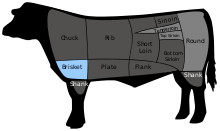Brisket

Brisket is a cut of meat from the breast or lower chest of
Method of cooking


Briskets can be cooked in many ways, including baking, boiling and roasting. Basting of the meat is often done during the cooking. This normally tough cut of meat, due to the collagen fibers that make up the significant connective tissue in the cut, is tenderized when the collagen gelatinises, resulting in a more tender brisket. The fat cap, which is often left attached to the brisket, helps to keep the meat from drying during the prolonged cooking necessary to break down the connective tissue in the meat. Water is necessary for the conversion of collagen to gelatine, which is the hydrolysis product of collagen.
Popular methods in the United States include rubbing with a
In the United States, the whole boneless brisket, based on the Institutional Meat Purchase Specifications (IMPS), as promulgated by the United States Department of Agriculture (USDA), has the meat-cutting classification IMPS 120. The North American Meat Processors Association publishes a photographic version of IMPS called the Meat Buyer's Guide.[1] The brisket muscles are sometimes separated for retail cutting: the lean "first cut" or "flat cut" is the deep pectoral, while the fattier "second cut", "point", "fat end", or "triangular cut" is the superficial pectoral. For food service use, they are IMPS 120A and 120B, respectively.
Other variations
Brisket has a long history in the United States.[2] Brisket is the meat of choice for slow smoking barbecue in Texas, and is often considered the "National Dish of Texas".[3]
In
In
In traditional

In
In Korean cuisine, traditionally it is first boiled at low temperature with aromatic vegetables, then pressed with a heavy object in a container full of a soy sauce-based marinade. The ensuing preserved meat is served in match-length strips as an accompaniment (banchan) to a meal. This is called jang jorim. Brisket is also the main ingredient in a spicy soup called yuk ke jang, part of the class of soups that are complete meals in Korean cuisine. Nowadays, it is also popular to cook thin slices of it quickly over a hot plate.[citation needed]
In Thai cuisine, it is used to prepare suea rong hai, a popular grilled dish originally from Isan in northeastern Thailand.[6]
In New Zealand cuisine, it is used in a boil-up. Boiled in seasoned water with green vegetables and potatoes, it is popular amongst Māori people.[citation needed]
It is a common cut of meat used in Vietnamese
In Italian cuisine, brisket is used to prepare bollito misto, a typical Northern Italy recipe.[citation needed]
In Pakistani cuisine, it is used in nihari, a popular dish.[citation needed]
In Mexican cuisine, brisket is used to prepare suadero tacos.[citation needed]
See also
References
- ^ "Meat Buyers Guide". Chefs-Resources.com. Retrieved 2011-06-08.
- ^ "Brisket History". hopscotchbrickovenmi. May 10, 2018. Retrieved April 27, 2020.
- ^ "Smoked Brisket Recipe - How To Smoke A Brisket". whatscookingamerica.net. 27 May 2015. Retrieved April 27, 2020.
- ^ Rabinovitch, Lara (2009), "Montreal-Style Smoked Meat:An interview with Eiran Harris conducted by Lara Rabinovitch, with the co-operation of the Jewish Public Library Archives of Montreal", Cuizine: The Journal of Canadian Food Cultures / Cuizine: Revue des cultures culinaires au Canada, 1 (2)
- ^ Christopher DeWolf; Izzy Ozawa; Tiffany Lam; Virginia Lau; Zoe Li (July 13, 2010). "40 Hong Kong foods we can't live without". cnngo.com. Archived from the original on November 5, 2012. Retrieved October 9, 2011.
- ^ "Suea hong hai". tasteatlas.com. Retrieved April 27, 2020.
- ISBN 1-931868-38-7. Retrieved April 27, 2020.
Further reading
- Moskin, Julia (August 19, 2014). "Brisket Is Worth the Wait". The New York Times. Retrieved March 17, 2015.
- Green, Aliza (2005). Field Guide to Meat. Philadelphia: Quirk Books. ISBN 1-931686-79-3.
External links
 Media related to Brisket of beef at Wikimedia Commons
Media related to Brisket of beef at Wikimedia Commons The dictionary definition of brisket at Wiktionary
The dictionary definition of brisket at Wiktionary


